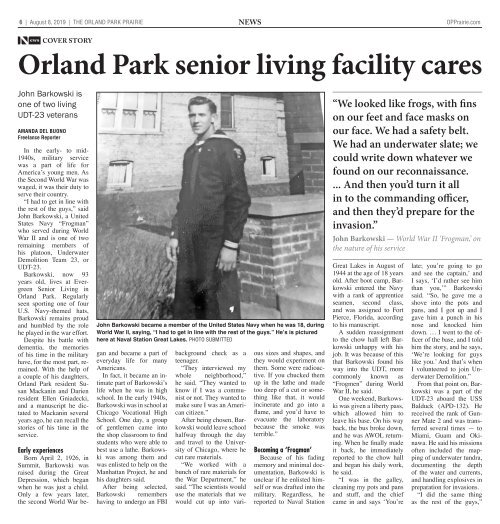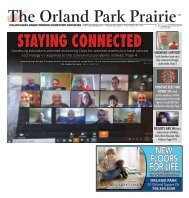Create successful ePaper yourself
Turn your PDF publications into a flip-book with our unique Google optimized e-Paper software.
6 | August 8, 2019 | the orland Park Prairie news<br />
<strong>OP</strong>Prairie.com<br />
Orland Park senior living facility cares<br />
John Barkowski is<br />
one of two living<br />
UDT-23 veterans<br />
Amanda Del Buono<br />
Freelance Reporter<br />
In the early- to mid-<br />
1940s, military service<br />
was a part of life for<br />
America’s young men. As<br />
the Second World War was<br />
waged, it was their duty to<br />
serve their country.<br />
“I had to get in line with<br />
the rest of the guys,” said<br />
John Barkowski, a United<br />
States Navy “Frogman”<br />
who served during World<br />
War II and is one of two<br />
remaining members of<br />
his platoon, Underwater<br />
Demolition Team 23, or<br />
UDT-23.<br />
Barkowski, now 93<br />
years old, lives at Evergreen<br />
Senior Living in<br />
Orland Park. Regularly<br />
seen sporting one of four<br />
U.S. Navy-themed hats,<br />
Barkowski remains proud<br />
and humbled by the role<br />
he played in the war effort.<br />
Despite his battle with<br />
dementia, the memories<br />
of his time in the military<br />
have, for the most part, remained.<br />
With the help of<br />
a couple of his daughters,<br />
Orland Park resident Susan<br />
Mackanin and Darien<br />
resident Ellen Gniadecki,<br />
and a manuscript he dictated<br />
to Mackanin several<br />
years ago, he can recall the<br />
stories of his time in the<br />
service.<br />
John Barkowski became a member of the United States Navy when he was 18, during<br />
World War II, saying, “I had to get in line with the rest of the guys.” He’s is pictured<br />
here at Naval Station Great Lakes. Photo submitted<br />
Early experiences<br />
Born April 2, 1926, in<br />
Summit, Barkowski was<br />
raised during the Great<br />
Depression, which began<br />
when he was just a child.<br />
Only a few years later,<br />
the second World War began<br />
and became a part of<br />
everyday life for many<br />
Americans.<br />
In fact, it became an intimate<br />
part of Barkowski’s<br />
life when he was in high<br />
school. In the early 1940s,<br />
Barkowski was in school at<br />
Chicago Vocational High<br />
School. One day, a group<br />
of gentlemen came into<br />
the shop classroom to find<br />
students who were able to<br />
best use a lathe. Barkowski<br />
was among them and<br />
was enlisted to help on the<br />
Manhattan Project, he and<br />
his daughters said.<br />
After being selected,<br />
Barkowski remembers<br />
having to undergo an FBI<br />
background check as a<br />
teenager.<br />
“They interviewed my<br />
whole neighborhood,”<br />
he said. “They wanted to<br />
know if I was a communist<br />
or not. They wanted to<br />
make sure I was an American<br />
citizen.”<br />
After being chosen, Barkowski<br />
would leave school<br />
halfway through the day<br />
and travel to the University<br />
of Chicago, where he<br />
cut rare materials.<br />
“We worked with a<br />
bunch of rare materials for<br />
the War Department,” he<br />
said. “The scientists would<br />
use the materials that we<br />
would cut up into various<br />
sizes and shapes, and<br />
they would experiment on<br />
them. Some were radioactive.<br />
If you chucked them<br />
up in the lathe and made<br />
too deep of a cut or something<br />
like that, it would<br />
incinerate and go into a<br />
flame, and you’d have to<br />
evacuate the laboratory<br />
because the smoke was<br />
terrible.”<br />
Becoming a ‘Frogman’<br />
Because of his fading<br />
memory and minimal documentation,<br />
Barkowski is<br />
unclear if he enlisted himself<br />
or was drafted into the<br />
military. Regardless, he<br />
reported to Naval Station<br />
“We looked like frogs, with fins<br />
on our feet and face masks on<br />
our face. We had a safety belt.<br />
We had an underwater slate; we<br />
could write down whatever we<br />
found on our reconnaissance.<br />
... And then you’d turn it all<br />
in to the commanding officer,<br />
and then they’d prepare for the<br />
invasion.”<br />
John Barkowski — World War II ‘Frogman,’ on<br />
the nature of his service<br />
Great Lakes in August of<br />
1944 at the age of 18 years<br />
old. After boot camp, Barkowski<br />
entered the Navy<br />
with a rank of apprentice<br />
seamen, second class,<br />
and was assigned to Fort<br />
Pierce, Florida, according<br />
to his manuscript.<br />
A sudden reassignment<br />
to the chow hall left Barkowski<br />
unhappy with his<br />
job. It was because of this<br />
that Barkowski found his<br />
way into the UDT, more<br />
commonly known as<br />
“Frogmen” during World<br />
War II, he said.<br />
One weekend, Barkowski<br />
was given a liberty pass,<br />
which allowed him to<br />
leave his base. On his way<br />
back, the bus broke down,<br />
and he was AWOL returning.<br />
When he finally made<br />
it back, he immediately<br />
reported to the chow hall<br />
and began his daily work,<br />
he said.<br />
“I was in the galley,<br />
cleaning my pots and pans<br />
and stuff, and the chief<br />
came in and says ‘You’re<br />
late; you’re going to go<br />
and see the captain,’ and<br />
I says, ‘I’d rather see him<br />
than you,’” Barkowski<br />
said. “So, he gave me a<br />
shove into the pots and<br />
pans, and I got up and I<br />
gave him a punch in his<br />
nose and knocked him<br />
down. … I went to the officer<br />
of the base, and I told<br />
him the story, and he says,<br />
‘We’re looking for guys<br />
like you.’ And that’s when<br />
I volunteered to join Underwater<br />
Demolition.”<br />
From that point on, Barkowski<br />
was a part of the<br />
UDT-23 aboard the USS<br />
Balduck (APD-132). He<br />
received the rank of Gunner<br />
Mate 2 and was transferred<br />
several times — to<br />
Miami, Guam and Okinawa.<br />
He said his missions<br />
often included the mapping<br />
of underwater tundra,<br />
documenting the depth<br />
of the water and currents,<br />
and handling explosives in<br />
preparation for invasions.<br />
“I did the same thing<br />
as the rest of the guys,”


















